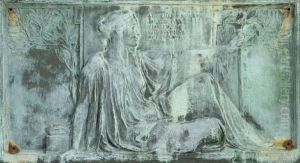Karl Theodore Francis Bitter Paintings
Karl Theodore Francis Bitter was a prominent Austrian-American sculptor known for his architectural sculpture, memorials, and residential work, blending Beaux-Arts classicism with a nuanced approach that made his work highly sought after in the late 19th and early 20th centuries. Born in Vienna, Austria, on December 6, 1867, Bitter demonstrated an early affinity for art, which led him to study at the Kunstgewerbeschule in Vienna, where he honed his skills in sculpture and design.
In 1889, at the age of 22, Bitter immigrated to the United States, where he quickly established himself in the vibrant New York art scene. His talent was recognized early on when he won a competition to carve the Astor Memorial doors of Trinity Church in New York City, setting the stage for a successful career. Bitter became a pivotal figure in American sculpture, contributing significantly to the Beaux-Arts movement in the United States. He was known for his ability to integrate sculpture with architecture, making his work a key element in the embellishment of buildings and public spaces.
Bitter's contributions to American art and architecture include work on the Thomas Jefferson Building of the Library of Congress in Washington, D.C., the Vanderbilt Mansion in Hyde Park, New York, and the 1893 World's Columbian Exposition in Chicago, where he served as the Director of Sculpture. His works often reflected themes of American patriotism, progress, and the human condition, resonating with the optimism and dynamism of the era.
Tragically, Bitter's life was cut short when he was struck by a car and killed in New York City on April 9, 1915, at the age of 47. Despite his premature death, Bitter's legacy lived on through his influential works and his role in shaping the visual landscape of America's Gilded Age. He left behind a rich legacy that continues to be celebrated for its artistic excellence and contribution to the American cultural heritage. Bitter was also instrumental in the formation of the National Sculpture Society, further cementing his impact on American art history.
